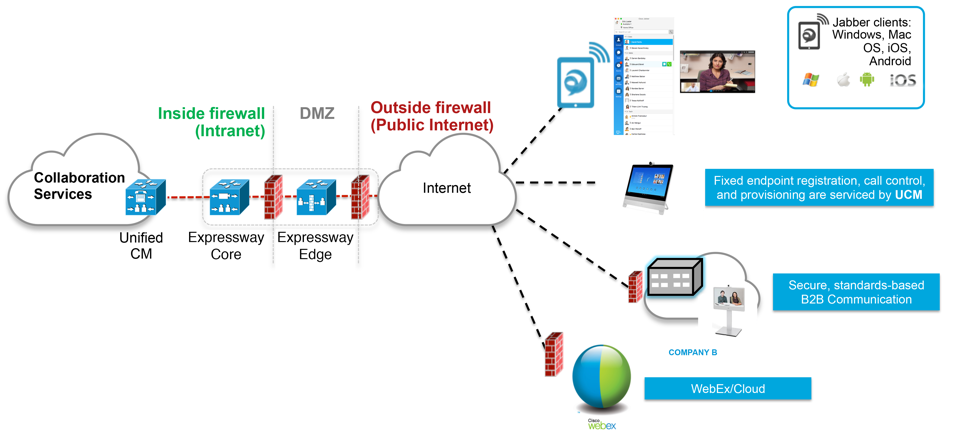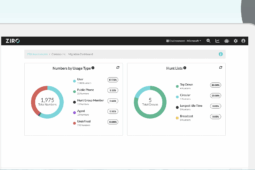Many are those who have deployed Cisco Unified Communications (UC) within their organizations: IP phones, Unified Messaging, Jabber for instant messaging and presence, softphone capabilities, and much more. There is no shortage of great benefits to implementing UC… However, communication with the outside world is still limited to sub-par audio calls through the Public Switched Telephone Network (PSTN) and the use of UC applications such as Jabber are still mostly constrained within the company’s walls (or firewall) unless you run one of those cumbersome VPNs. Enter Cisco’s Collaboration Edge Architecture with, at its core, a single solution that does it all: Cisco Expressway.
Connecting Your Workforce Outside of the Company’s Firewall
In 2016, teleworking is becoming the norm, whether working full-time from a home office or part-time during “working moments” – at home before the morning commute, in the cab ride between meetings or at the coffee shop during lunch. Expressway, with its Mobile Remote Access (MRA) feature, allows the secure use of Jabber, on any platform, desktop or mobile, without the need for a VPN. As such, instant communication with colleagues is available through IM, audio calls and even video calls from wherever you are.
For the full-time teleworkers, a fixed desk phone or video endpoint can become a huge productivity booster. Expressway enables the secure connectivity of remote endpoints to your organization’s Unified Communications environment. Personal video endpoints deployed in the home office, such as Cisco’s DX70 or DX80, will completely break the distance barrier for teleworkers allowing them to feel as an integral part of the team by leveraging video communication.
Video for All, Video with All
The day is near when all calls will have a visual support along with the voice of the parties. However, one key piece of the puzzle is missing: for external calls with customers, suppliers or any parties outside of your organizations, we still rely on the PSTN which is, sadly, missing support for video. And this is not going to change anytime soon… As such, we have to transport Business-to-Business (B2B) video calls on a different network which will happily transport video – ever heard of the Internet? Simple enough, but exposing Unified Communications environments and video endpoints directly on the Internet quickly becomes a very big security concern. Again, Expressway saves the day.
Cisco Expressway is comprised of two servers: Core and Edge. The Expressway Core server will sit within the company’s firewall, next to other UC application servers such as Cisco Unified Communications Manager (CUCM), Cisco Unity Connection (CUC), etc. As for Expressway Edge, it is deployed in a DMZ. The role of the Edge server is similar to that of a proxy, in the sense that it will redirect all of its traffic flows from remote users and endpoints to the Core server inside the network. The latter will then redistribute the traffic to their right destination within the company’s internal network. This results in very tight firewall rules and a secure network while enabling UC services with the external world.

By integrating SIP URI dialing to our organization’s dial plan, and by using Expressway as the means to provide secure communications using the Internet as the transport, both B2B audio and video calls are now possible. A few years back, postal addresses were traded for email addresses – soon, PSTN phone numbers will be replaced by SIP URIs.
Federation or Sharing Instant Messaging and Presence with Others
An incredibly efficient means of communication, prized by the younger generations who grew up chatting and texting away on their smartphones, enterprise instant messaging (IM) solutions, such as Cisco Jabber, were always typically confined to internal contacts. Those who wanted to circumvent those limitations needed to turn to public IM services such as MSN, Skype, and others. Great for personal use, those public IM networks have inherent security flaws which make them unsuitable for conducting business.
Federation is the mechanism which enables IM and Presence between different entities. Again, since the network between organizations is the public Internet, organizations required a mean to secure those IM and Presence federations: Expressway, yet again. Similarly to B2B audio and video calls, Expressway ensures that federated IM & Presence traffic will flow through the company’s firewall in a secure fashion.
Far from Being a One-trick Pony
Besides all of its great functionalities described above, Cisco Expressway provides edge services for these additional UC applications:
- Collaboration Meeting Rooms Hybrid (CMR Hybrid): secure link with the WebEx cloud for sessions where audio, web, and now video participants using video endpoints can all collaborate seamlessly.
- Spark: secure link with the Spark cloud, also known as the Cisco Collaboration Cloud (CCC).
- Microsoft interoperability: enable video calls between Cisco endpoints and Lync/Skype for Business users.
- Jabber Guest: allow external parties to call internal users using audio and video from a web browser.
- Video interoperability: enable calls between H.323 and SIP endpoints, both within and outside the company’s firewall.
What Are You Waiting for?
There is no doubt in my mind that Cisco Expressway should be somewhere at the top of your list of Unified Communications projects for the coming year, should you not already have it deployed in your environment. By expanding UC beyond the company’s firewall, remote users, business partners and internal users alike will notice tremendous gains in productivity, efficiency, and flexibility in the way they can now communicate. One more reason to deploy Expressway as soon as possible: it is absolutely free when deployed for Mobile Remote Access! Don’t live on the Edge, make the jump to Cisco Expressway.
Want to take advantage of all of the Cisco Expressway benefits and need some help getting it set up and rolled out. Our team of experts are ready to support you with this process. Give us a call and we can discuss the process and timeframe with you, so you can decide if this is the right time to make the jump to Cisco Expressway.
Ready to take your unified communications from headache to hassle-free?
No throwing darts at proposals or contracts. No battling through the back-end. No nonsense, no run-around.



